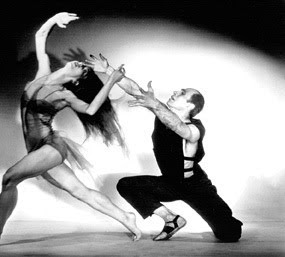
In 1928 when Jose moved to New York to study art he began to feel that he couldn't make anything of value because of the medium had been mined out and it was by chance when his girlfriend took him to see the dancer, Harald Kreutzburg perform. NOTE: Kreutzburg was a German dancer and choreographer who trained at the Dresden Ballet School, Kreutzburg also studied dance with Mary Wigman and Rudolf Laban. Apparently, Limon was stunned; "Suddenly, onto the stage, born on the impetus of the heroic rhapsody, bounded an ineffable creature and his partner. Instantly and irrevocably, I was transformed. I knew with shocking suddenness that until then I had not been ALIVE or, rather that I had been unborn... now I did not want to remain on this earth unless I learned to do what this man was doing."
I suppose a big thanks to his girlfriend, Limon started studying all the dance he could. Limon enrolled in the Humphrey-Weidman school. He learned basic technique from Doris Humphrey and pantomime and expression from Weidman. Limon would attribute his primary stylistic influences to Isadora Duncan and Harald Kreutzberg.
Limon was a compassionate individual, who felt deeply the sorrows and injustices visited upon people. His masterpiece, The Moor’s Pavane, created for his company in 1949 and still in the active repertory of many ballet companies today, is a distillation of the Othello story reduced to four characters: Othello, Iago, Desdemona and her servant. It is a model of economy in its swift delineation of the characters and the essential conflict. Its power derives from the clarity and brevity with which it is presented. The work is a tribute to the effect Doris Humphrey had on Limon. She was his constant editor, always ready to help him look for the essential in movement, and to reach for the most direct mode of expression. In the piece none of the characters ever leave the stage. Limon knew he couldn't get all the politics and details of the play into his piece. What interested him particularly was the subject of jealousy and the use of the pavane (a slow, stately dance from the 16th century, probably originating in Italy). He liked the formality and ceremony of the pavane at the center of the stage. In the corner of our minds and hearts lies the drama. The pavane never ends regardless of what is happening: A court dance is transformed into a daily dance.
Watch Jose!-- Moor's Pavane Exceprt--
"THE FORM IS THE MESSAGE. HE UNDERSTOOD THAT VERY
WELL. HE HAD A FANTASTIC SENSE OF FORM."
"Jose always knew what he wanted," Condodina said. (Condodina was a member of the Limon company in the 1960s and early 1970s, the last generation of dancers who worked with Limon.) "He saw us as instruments but would adapt his vision to our DNA. Often there were conversations back and forth about you as an instrument and his goal. His works adapt well to different people. In setting his dances, it is important to be as open-minded as he was."
Interesting!! Etude, a three minute solo male exercise in Limon's movement vocabulary, created by company artistic director, Carla Maxwell for the 2002 Winter Olympics dance education series, emphasized upward, searching gestures and flowing turns, where the arms seemed to become entangled in the vortex of the turn.
Take a look: http://www.limon.tv/

I think it is very interesting to study Limon. I read his memoir for modern my first semester and felt like I had a lot to relate to. First of all his transition into dance was quite amazing he discovered through just exploring the current art scene. "I knew with shocking suddenness that until then I had not been ALIVE or, rather that I had been unborn..." I specifically remember this quote from the memoir and think that is one of his first most powerful and dramatic statements. I also think that it is very interesting that the work of Jose is so greatly influenced by Doris Humphrey. It is interesting how Doris was working in the scheme of things. As we learned Doris was big into composition and wrote the first modern dance composition book. I think without the direction of Doris Jose's visions may not have evolved to what has become American masterworks.
ReplyDeleteThat's an interesting note about Doris, and how without her influence Jose's visions may not of evolved the way they did. It's kind of amazing seeing how all these great people in dance history link somehow. Someone is inspired by someone else, someone has learned from someone else... It's all a chain of great people, and we have such an advantage to look back and learn. I like to think what it'd be like if the people we are studying, more so the ones who are not with us anymore, saw dance today, and what they would think. Them seeing, their own influence and how it has evolved since then. I think they would be very appreciative.--Just a little note. :)
ReplyDelete